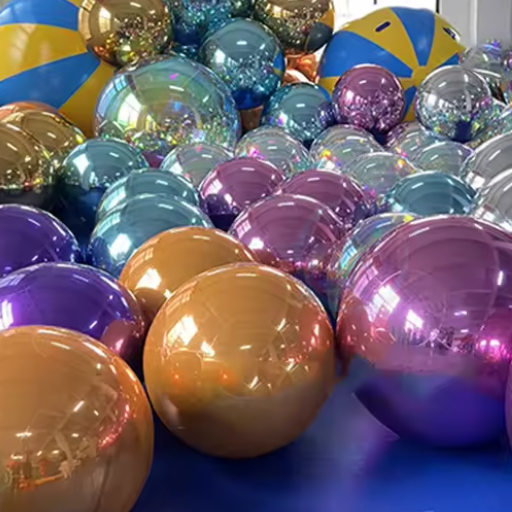Although traveling with balloons isn’t probably the first idea that occurs to you while packing, it is indeed a nicely new instance with special difficulties and also a very common one. Whether you are going to take balloons with you for a special occasion or as part of your business, it is very important to know the policies of the airlines and the TSA about them. There are concerns about the balloons bursting at the high altitudes and an awareness of what can or cannot pass through security, and it turns out there is much more to take into account than what comes to mind at first. You will be walking through all the aspects of traveling with balloons—be it deflated, inflated, or in any other form—by following this guide, thus being able to fly on your next flight without worries.
Introduction to Bringing Balloons on a Plane

Air travel with balloons is not only permitted but also a matter of decision with a few crucial conditions, to be followed. In the case of deflated ones, there will not be any problem in putting them in either the carry-on or the checked luggage.
The Importance of Knowing Airline Policies
Knowing and following airline policies on balloons is of major importance and will above all give you a smooth and trouble-free trip. Airlines and the TSA have strict regulations about what has to be and what cannot be brought on board, and these rules often differ from one airline to another. For example, while deflated balloons are usually okay in carry-on luggage, there might be a problem with the inflating ones because of the limitation of the cabin space and the bursting risk at high altitudes.
⚠️ Important Safety Information: If the balloon is filled with air or helium it will expand because of the air pressure change during the flight, thus, it might rupture. Besides, some airlines could even impose a limit on the amount of helium that can be transported, labeling it as a hazardous material. According to TSA regulations, helium tanks or canisters meant for inflating balloons are not allowed in either carry-on or checked baggage; hence it is necessary to prepare well in advance for any celebration involving balloons.
Why Travelers Might Want to Take Balloons
Initially, it might seem strange that people would travel with balloons, but there are many reasons that balloons have become a common item among travelers. Balloons are not only lightweight and foldable but also adaptable and fabulous for illumination in various travel situations. For example, balloons can act as cheap and beautiful decorations for suddenly planned celebrations—like birthdays, anniversaries, etc.—that happen while traveling. They give a party-like effect to gatherings without being a great burden in terms of luggage space.
Airline Regulations for Balloons on Airplanes

TSA Guidelines on Balloons
Deflated balloons of natural latex or Mylar are more likely to be accepted in both hand and checked luggage. They are not a part of security risks and hence, the general rules apply to them. Nevertheless, it is still better to pack them in such a manner that the TSA staff can easily see what the items are during the X-ray screening.
The TSA does not allow travelers to bring along a carrier of compressed helium tanks (the very ones used to inflate balloons) in any type of baggage due to concerns relating to safety. Such containers that are under pressure are likely to explode at high altitudes and thus pose a danger and are treated as hazardous materials. In case you are visiting a place which has helium balloons, it is better to make arrangements with a vendor in advance for getting them filled.
Balloons that have been inflated with air or helium may be subjected to more scrutiny than others. The changes in pressure during the flight may cause such balloons to swell up considerably. Even though this would not be a breach of the TSA policies, the airlines might still impose their own restrictions because of safety and passenger comfort.
Specific Policies from Major Airlines for Traveling with Balloons
| Airline | Balloon Policy |
|---|---|
|
1. American Airlines
|
American Airlines allows carrying balloons in either carry-on or checked luggage, provided that they meet the size and weight criteria. However, all helium-filled balloons are to be deflated before boarding the aircraft so that the airline can avoid any pressure-related safety issues at high altitudes. |
|
2. Delta Air Lines
|
Delta permits the transport of balloons by passengers, but the balloons must be non-flammable and must not interfere with safety equipment. Deflated balloons are allowed in the cabin, while big deflated arrangements might have to be checked. Helium-filled balloons are not permitted in the cabin unless they are completely deflated before the flight. |
|
3. United Airlines
|
United Airlines accepts the carriage of balloons on their flights, but they should be deflated before entering the plane. The company warns customers not to bring fully inflated balloons as they might be contrary to the aircraft’s cabin policy regarding space. Also, when packing balloon items, it is advisable for guests to check the size of their carry-on or checked luggage. |
Types of Balloons and Their Impact on Air Travel

Balloons are a type of air travel that has different consequences. From what I have gone through, most companies have a very strict policy regarding the matter. It is necessary to take helium balloons out of the bag before boarding if they are to meet the regulations concerning safety and space. It is very important to contact the airline in advance and to confirm that any items related to the balloon are within the baggage size restrictions.
Helium Balloons: Advantages and Disadvantages
✓ Advantages
Floating and Extremely Light
Helium being lighter than air can easily float these balloons to the sky. Since the balloons are light, they may not contribute much to the weight of the checked luggage and hence can be included when the weight limit of the airline is being adhered to.
Longevity of Balloons for Flying
Again, latex or foil helium balloons, if properly sealed, can retain helium for several hours to days. For instance, foil balloons usually retain helium for 2-7 days, hence they become versatile and trustworthy for a celebratory event planned just after arrival.
Compact Choices There
You can take deflated helium balloons by packing them tightly and inflating them at the destination, avoiding the situation of carrying fully inflated balloons. Portable helium tanks are now becoming more widely available for purchase too, which is an added convenience.
✗ Disadvantages
Inflation Limitations During Air Travel
Due to limited space and the danger of bursting caused by the change in air pressure during the flight, the completely inflated helium balloons may not be permitted in either the cabin or cargo. The Federal Aviation Administration (FAA) warns tourists that the pressure differences at high altitudes can cause the helium in the balloon to expand, thereby causing the balloon to burst.
Helium Tanks: A Safety Risk
Passengers bringing helium tanks to inflate the balloons later must be aware that compressed gas cylinders are almost entirely banned on commercial flights due to Transportation Security Administration (TSA) regulations.
Concerns for the Environment
The environmental footprint of balloons, especially those made of latex or foil, is now being put under scrutiny and thus awareness has been raised. Helium balloons when released or improperly disposed of can be a threat to wildlife and the ecosystem. Research has shown that marine life often confuses balloon remains with food, which results in a deadly situation for them.
Packing Tips for Safe Balloon Transportation

In case balloons are being delivered, the first thing I suggest is to make them into smaller ones and pack them that way, this will help in saving space as well as protecting the balloons. When you get to where you are going, a small pump can still be used to reinflate them for ease of use.
How to Properly Inflate Balloons Before Travel
Choose the Right Inflation Method
In the case of latex balloons, it is better to use either a hand pump or an electric air pump rather than blowing them up manually. This way no moisture gets in the balloon and the latex won’t be weakened thus lasting longer. On the other hand, foil balloons can be filled with helium from a tank or an inflation straw.
Avoid Overinflation
Overfilling a balloon can create pressure that is not balanced and hence will lead to popping, especially during transport. For latex balloons, the goal should be to fill them up to 90-95% of their size, so to speak, leaving a “neck” at the top to allow for expansion. Foil balloons should be inflated to where they feel strong but not hard, as too much pressure may result in seams bursting.
Consider the Altitude Impact
If you are flying to a place with a higher altitude, the balloons will probably get bigger because of the decrease in air pressure. So, in order to avoid bursting, balloons should be inflated a little bit less than usual thus leaving room for expansion during the journey.
Best Ways to Pack Deflated Balloons
- 📦 Place Balloons Away from Pointy Items:
To eliminate the risk of accidental punctures, keep the deflated balloons in a protective bag or container. Resealable plastic bags are a good option as they give the balloons protection from physical damage and also keep them neat and organized. - 🌡️ Manage Temperature and Humidity:
Heat or moisture can destroy balloon materials, especially latex. The best latex storage temperature range is 10°C–25°C (50°F–77°F) and with dry air; thus, following these balloon care guidelines will make the latex stay elastic and durable. - ☀️ Do Not Place Under Direct Sunlight:
UV rays are one of the main reasons that latex or foil balloons get weaker as time goes by. It is suggested by the specialists that balloons should either be kept in opaque containers or in non-sun exposed storage areas to maintain their strength and color.
Alternative Solutions for Celebrations While Traveling

While on a journey, I prefer to bring along portable decorations like banners or LED lights that can be mounted across the whole room just like balloons. They weigh little, are usable multiple times, and can be packed easily. In this way, I am able to still make a celebration spot without the stress of storage or damage to the decorations.
Using Travel-Friendly Decorations
Choosing easily portable decorations plan and releasing them for celebrations or events that are not at home may be both practical and eco-friendly. Fabric banners, LED string lights, and collapsible decor elements are examples of options that take little space and weight, help make your event charming and even more so by their transportation issue being minimized. Reusing decorations can cut waste by as much as 40% according to a study conducted in 2023 which consequently leads to a great improvement in the gatherings’ environmental impact. Many travel-friendly items such as paper fans or modular decor kits are very easy to assemble and disassemble which makes them ideal for repeated use.
Moreover, if you select decorations made from eco-conscious materials like recycled paper or biodegradable fabric, then it is almost how you encaged aesthetics with green. For instance, making it a point not to use helium-filled balloons but rather opt for foldable paper lanterns not only brings your cost down but also the pollution level. These considerate substitutes enable you to present beautiful arrangements that are light, reusable, and compatible with eco-friendly practices.
Local Options for Balloon Purchases
When planning a party that will feature balloons, it is necessary to find a good compromise between giving preference to environmentally friendly options and local businesses. Biodegradable latex balloons are often sold by local party supply stores as a sustainable alternative to traditional balloons. These eco-friendly balloons eventually degenerate and thus are able to lessen their impact on the environment and at the same time give the same look.
🌱 Supporting Local & Sustainable: Along with this, “locally-made party supplies” inquiries have also risen by 30% in the same timeframe, thus pointing towards the direction of consumers being more inclined toward supporting small businesses while being environmentally conscious. Therefore, when you explore these local options, your celebrations will not only be colorful but also eco-friendly.
Reference Sources
-
Transportation Security Administration (TSA)
- Source: Balloons (not inflated) | Transportation Security Administration
- This official TSA page outlines the rules for carrying deflated balloons in both carry-on and checked luggage.
-
Quora Discussion on Airline Policies
- Source: Am I allowed to carry inflated balloons in an airplane?
- This discussion provides insights into the experiences of travelers and the variability in airline policies regarding inflated balloons.
-
TSA Miscellaneous Items Guidelines
- Source: Miscellaneous | Transportation Security Administration – TSA
- This page includes a broader list of items allowed or restricted by TSA, including balloons, and offers guidance for travelers.
Frequently Asked Questions (FAQs)
❓ Can You Bring a Balloon on an Airplane?
Bringing a balloon on a plane is allowed, but you need to know different rules that apply. The majority of the airlines consider balloons as part of your hand luggage and may allow them, but it is better to check with the airline about their own rules.
❓ Do Airlines Indicate Foil Balloons Are Not Allowed on Flights?
Airlines might not allow to carry foil balloons at all because of concern for safety. Foil balloons can be a hassle by disrupting the working of navigation equipment on the plane, thus it would be a good idea to confirm with your airline beforehand.
❓ Can I Take in My Checked Bags Balloons That Are Deflated?
Deflated balloons can be considered as being packed in your checked luggage with no problems to arise. If you are going to pump them up while flying, then you might want to be aware that they could increase in size because of the pressure adjustment in the confined air cabin.
❓ Will the Balloons Occupy the Space for the Overhead Bin?
The size of the balloon and its state whether it is filled or not is what will determine if it will fit in the overhead bin. While a regular balloon might fit, enormous or already inflated ones could require being secured in a different manner so as not to block any storage areas.
❓ Are Balloons a Trouble at Airport Security Checkpoints?
Balloons usually do not give a hard time to airport security checkpoints. Security staff might request you to let air out of the balloons or even investigate what’s inside them in case of any doubt on the material.
❓ What Happens to Balloons at the Time of Cruising Altitude?
The balloons may behave the same way by getting bigger and even bursting because of the changes in pressure at cruising altitude. It is better to have them deflated or make sure they are in a strong container to prevent any loud noises from startling passengers during the flight.
📌 Key Takeaway
Always remember to deflate your balloons before boarding, check with your airline for specific policies, and consider eco-friendly alternatives for your celebrations. Safe travels and happy celebrating!










